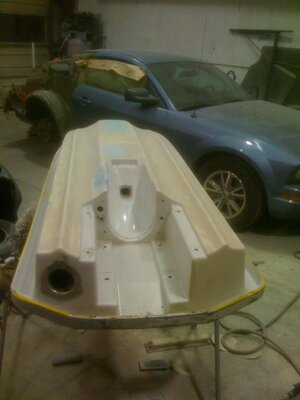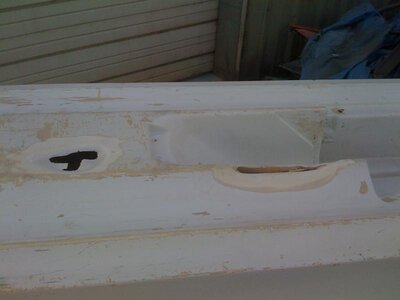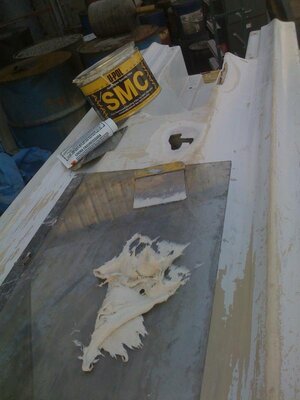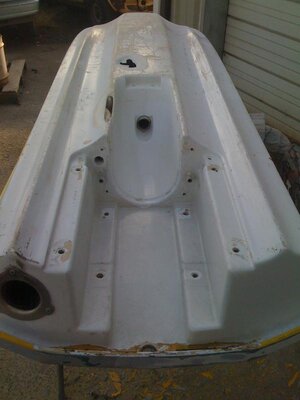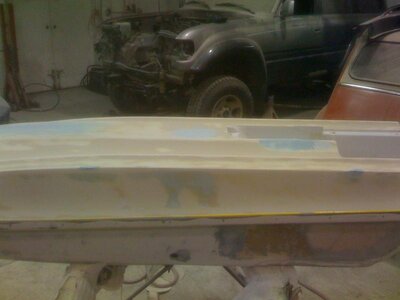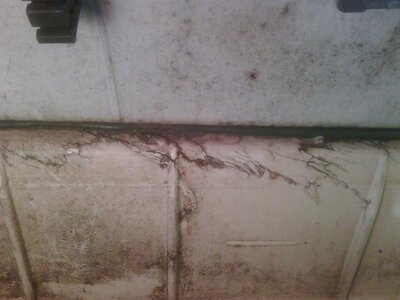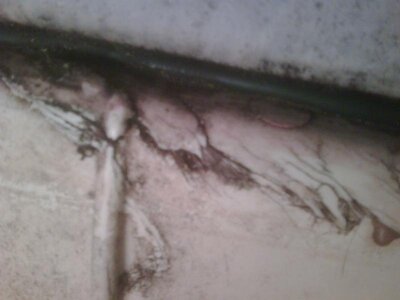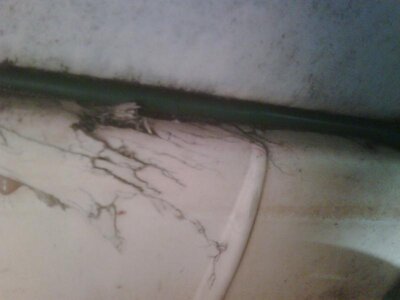I have a squarenose sj I just stripped everything out of to reinforce and paint. When I did I realized a crack about a foot long. It is in the bottom half of the hull right under the bondline. In the middle of the crack it is kind of split and pushed in a little and the fiberglass is wet. If I sand it out pretty good and reinforce it will it be strong or will it always be weak with a crack like that is it better to find a new hull.
You are using an out of date browser. It may not display this or other websites correctly.
You should upgrade or use an alternative browser.
You should upgrade or use an alternative browser.
need help with superjet
- Thread starter doubletrailerz
- Start date
WaveDemon
Not Dead - Notable Member
- Location
- Hell, Florida
dig out all the the wet SMC and put extra fiberglass there. make patches go from small to big in that spot. when you do full size reinforcement you won't even notice the patches.I have a squarenose sj I just stripped everything out of to reinforce and paint. When I did I realized a crack about a foot long. It is in the bottom half of the hull right under the bondline. In the middle of the crack it is kind of split and pushed in a little and the fiberglass is wet. If I sand it out pretty good and reinforce it will it be strong or will it always be weak with a crack like that is it better to find a new hull.
make sure you use epoxy resin.
leprechaunjohn
john john the leprechaun
- Location
- Mobile/Auburn, Alabama
pics?
stanton
High on jetskis.
- Location
- atascadero,ca
first off use smc not glass on the bottom half of your ski glass will not work and yes if you grind out all of the "cancer" it will be just as strong as the rest of the ski especially if you reinforce the hull
use smc??:dunno:
ya smc what you no read the English glass wont stick it will stress crack and rot i just fixed the bottom of a RN SJ i bought because someone used glass instead of smc!:banghead:use smc??:dunno:
Attachments
Last edited:
stanton
High on jetskis.
- Location
- atascadero,ca
ya smc what you no read the English glass wont stick it will stress crack and rot i just fixed the bottom of a RN SJ i bought because someone used glass instead of smc!:banghead:
not what im sayin. how can you use smc its a molded fiberglass compound. all you need is epoxy resin with adequate preparation. ive got plenty of fiberglass on my smc with zero delam.
i didnt know there was smc specific resins out there, but the fiberglass is not the problem.www.fibreglast.com said:A new composite material is gaining widespread use in the automotive, industrial, and personal watercraft markets that presents unique repair problems. It is called SMC, or Sheet Molded Compound. Recognizing SMC from other types of FRP composites
is critical so the proper repair can be performed. Parts made with SMC are produced in compression molds, so they are smooth on both the inside and outside. That is the first clue to look for when identifying them. Next, SMC parts do not have an outer gel coat, but they are usually painted or color molded. When the paint is sanded off, the underlying surface has a marble appearance. Finally, when damaged SMC is sanded, short coarse fibers are exposed and a dryer powdery dust is produced compared to conventional materials. These hints will make SMC identification quite straightforward. SMC is a polyester-based material, but it cannot be repaired with polyester resin. This is due to the mold release agent that is present throughout the entire SMC part. Unlike conventionally molded parts where release agents are applied to the mold surface, SMC is compounded with them in the resin mix for quicker processing. This means that as the damage is sanded to prepare a good bonding surface, fresh mold release agent is exposed. Polyester resin products are not strong enough to adhere to this surface. SMC SHOULD ONLY BE REPAIRED USING EPOXY-BASED RESINS, FILLERS AND ADHESIVES.
Last edited:
joe b
depth tester
- Location
- northfield, nj
ya smc what you no read the English glass wont stick it will stress crack and rot i just fixed the bottom of a RN SJ i bought because someone used glass instead of smc!:banghead:
The glass is not the problem it's the resin used then the prep. I would have filled the holes with something stronger than filler. I'm guessing your planing on layering glass on both sides. I know nothing about that smc filler and I'm curious what it's made from. Most fillers are porse power base and will absorb water. I've been using 3m marine filler that is a ester with glass bubble formula.
Mike W
Infidel
- Location
- North Florida
Epoxy resin with 404 filler would of worked well for that repair.
snowxr
V watch your daughters V
- Location
- Waterford, MI
first off use smc not glass on the bottom half of your ski glass will not work and yes if you grind out all of the "cancer" it will be just as strong as the rest of the ski especially if you reinforce the hull
^ disregard that. Use epoxy resin and fiberglass. Grind out the bad, and fill it in. Sand it smooth with coarse grit sand paper, then reinforce your hull.

